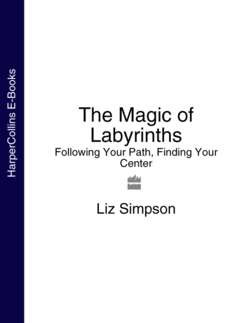Читать книгу The Magic of Labyrinths: Following Your Path, Finding Your Center - Liz Simpson - Страница 17
Labyrinths and Christianity
ОглавлениеIt may seem surprising that a symbol so obviously associated with pagan beliefs came to find its way into so many Christian churches. However, the taking over of pagan symbols and ideas was something the Roman Catholic Church engaged in extensively. For example, pagan communities tended to celebrate festivals every six to eight weeks, to mark the changing seasons and solar cycles. Because these were so well established throughout northern Europe, particularly in Britain, many were simply overlain with Christian symbolism. Hence, Yule or the winter solstice became Christmas, Samhain became All Saint’s Day, and the spring equinox became Easter. The latter festival, incidentally, is named after the German fertility goddess Eostre or Ostara, which comes from the same root as the female hormone oestrogen. Not surprisingly, given the fertility link and the nature of female reproduction, the symbol of Eostre is an egg – hence the notion of Easter eggs, which was a custom engaged in by pagan communities long before Christianity came on the scene.
Indeed, it has been argued that the Christian figure of Mary, mother of Jesus Christ was recreated from the ancient concept of the Great Mother Goddess in her triple archetypal roles of Virgin, Mother, and Wise Woman. There were certainly plenty of precedents for virgin births among the pre-Christian pantheon of Gods. The oldest of divinities, Gaia, appeared out of nothing to give birth to Uranus, the starlit sky, while the patriarch of the Greek gods was originally called Zeus Marnas or “Virgin born Zeus.” Any number of Greek heroes, including Perseus who slayed the Gorgon Medusa, and Jason of Argonaut fame, were said to be virgin born. The reason why the Christian church has resisted the worship of Mary as anything other than the earthly mother of Jesus was because she was based on a composite of many pagan goddesses. However, by giving this archetype a role to play within its religion, the Catholic Church ensured that their new, monotheist, patriarchal religion became relevant to people who were polytheist and largely matrifocal. As well as re-defining the Mother Goddess as the Virgin Mary, the Church changed many other pagan deities into saints. In one example, the Celtic goddess Brighid became St. Brigit (or Brigid).
In the same way that the Holy Roman Church appropriated existing pagan archetypes and festivals, it built its places of worship on sites which ancient peoples had long revered for their sacred energy. Many churches in England were built on “ley lines” (the phenomenon of electromagnetic energy sometimes called Earth “chi”) because the only way the Catholic church could integrate non-Christians into their own religion was to appropriate the sacred sites at which they already worshipped.
The labyrinth is a wonderful tool that engages people easily and that can be used to address deeper issues around spirituality and the best way to journey through life. So, instead of throwing the baby out with the bathwater, the Christian Church appropriated it for its own needs. The Christian church could not change people’s long-held faith, so they simply Christianized it. In the process, to set theirs apart from pagan examples, church labyrinths became more intricate in their design and ornate in their execution. They also became associated with Biblical cities, such as Jerusalem and Jericho – the latter possibly deriving from the Roman view of labyrinths as a kind of fortified city.
